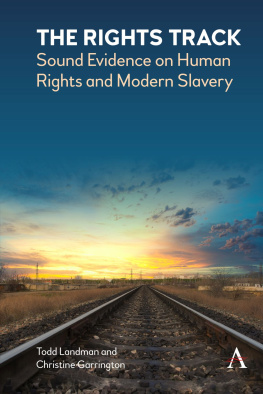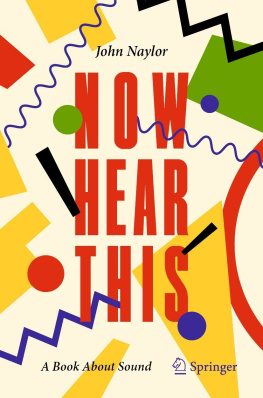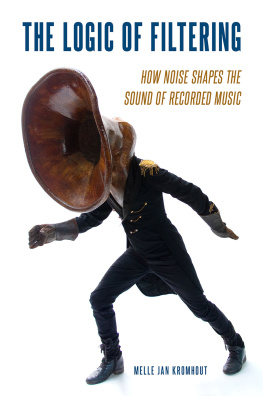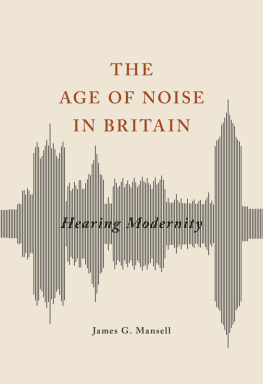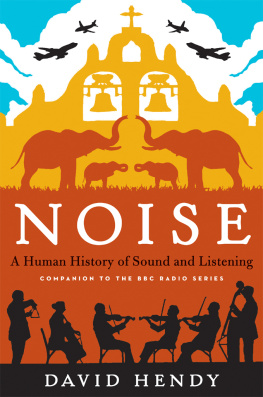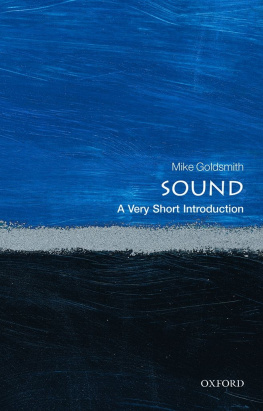Noise
Noise
A Human History of Sound and Listening
DAVID HENDY

First published in Great Britain in 2013 by
PROFILE BOOKS LTD
3A Exmouth House
Pine Street
London EC1R 0JH
www.profilebooks.com
Copyright David Hendy, 2013
Based on the BBC Radio 4 series.
The radio series was produced by Rockethouse Productions.
1 3 5 7 9 10 8 6 4 2
Typeset in Galliard by MacGuru Ltd
info@macguru.org.uk
Printed and bound in Great Britain by
Clays, Bungay, Suffolk
The moral right of the author has been asserted.
All rights reserved. Without limiting the rights under copyright reserved above, no
part of this publication may be reproduced, stored or introduced into a retrieval
system, or transmitted, in any form or by any means (electronic, mechanical,
photocopying, recording or otherwise), without the prior written permission of
both the copyright owner and the publisher of this book.
A CIP catalogue record for this book is available from the British Library.
ISBN 978 1 78125 089 1
eISBN 978 1 84765 944 6
The paper this book is printed on is certified by the 1996 Forest Stewardship
Council A.C. (FSC). It is ancient-forest friendly. The printer holds FSC chain of
custody SGS-COC-2061

For Henrietta, Eloise and Morgan
Contents
Introduction
Were supposed to hate cacophony, but a few years ago on a cold Sunday in Berlin I was struck by the horror that sometimes lurks in silence and by the warm humanity that often emanates from noise. My teenage daughter and I had taken a suburban train north from the city centre to visit the old Sachsenhausen concentration camp in Oranienburg, where more than 200,000 people had been imprisoned under the Nazis. It was still early when we arrived, and only a few other people were around; a chilling mist, which clung to the place all morning, only added to the bleak atmosphere. Its utter noiselessness seemed oppressive yet entirely appropriate: whatever life the camp had once contained had been expunged cruelly many years ago. As the two of us walked around, looking at the evidence of one atrocity after another, it was difficult to know what to say to each other. So, like everyone else, we stayed silent.
After a few hours of this, and knowing we had to catch a flight home later the same day, we decided that we needed to cheer ourselves up pretty quickly. We caught the next S1 train back to the city centre and made our way to Caf Einstein for cakes and coffee. The moment we stepped inside this venerable wood-panelled Weimar institution, crammed to bursting point with Berliners having their Sunday afternoon treat, we were hit by an extraordinary wall of sound. The idea of finding somewhere quieter never occurred to us, however. The clatter and clinking of cutlery and crockery as waiters hurried from table to table, the ringing of tills, the shouting of orders from the kitchen and, rising above everything else, the constant loud buzz of conversation and laughter coming from everyone: after a long mornings silence this din was a blissful affirmation of life, a sonic two-fingers to the Nazis and the deathly silence they had created at Sachsenhausen.
Noise, it has been said, is sound that is out of place. But on that day in Berlin I saw, as I hope to argue in this book, noise is more important than this. When the bell rings, a factory siren sounds, or the skies fall silent after a terrorist attack, noise or its absence is charged with meaning. Noise has been a capacious category throughout human history one full of surprises and drama.
I am with John Cage. Wherever we are what we hear is mostly noise, he wrote in 1937. When we ignore it, it disturbs us. When we listen to it, we find it fascinating.
So although this book has the word noise prominently in its title, it is trying to stretch the definition as far as it will go and in lots of directions, too. It encompasses not just music and speech but also echoes, chanting, drumbeats, bells, thunder, gunfire, the noise of crowds, the rumbles of the human body, laughter, silence, eavesdropping, mechanical sounds, noisy neighbours, musical recordings, radio, in fact pretty well anything that makes up the broader world of sound and of listening. When I turn to oratory in ancient Rome and in modern political campaigning, for example, I am interested in the words spoken but I am even more interested in the sounds made: the tone, the cadences, the pitch of the voice; how that voice might have been transformed by the environment in which it was heard, and how the audience responded. When I discuss the jazz scene in Harlem during the 1920s, it is less the musical quality of Mamie Smith or Ma Rainey that concerns me and more the impact recording had in allowing new sounds to circulate well beyond a small group of people gathered at a concert or dance-hall and in allowing the voice of a marginalised culture to be heard as never before by an international listenership.
Having said all this, I still want to hold on just a little bit to that original idea of noise as a nasty, troubling thing. For although I think noise is not always a sound out of place, nor always strictly speaking unwanted, it can perhaps be thought of as a sound that someone somewhere doesnt want to be heard. By that, I mean that who gets to make a noise and who doesnt, who gets their voice heard and who doesnt, who gets to listen and who doesnt, is of crucial importance. Silence can be golden, or it can be oppressive. And as the history of slavery, or the history of the relationship between factory-owners and their workers shows us, whether it is enforced or voluntary makes a world of difference. So this book is really about how sound might help us understand some of the drama and struggle of human history in a new and, I hope, enlightening way.
To trace the story of sound is to tell the story of how we learned to overcome our fears about the natural world, perhaps even to control it; how we learned to communicate with, understand and live alongside our fellow beings; how we have fought with each other for dominance; how we have sought to find privacy in an increasingly busy world; how we have struggled with our emotions and our sanity. It encompasses the roar of the baying crowd in ancient Rome, medieval power struggles between rich and poor, the stresses of industrialisation, the shock of war, the rise of cities, the unceasing chatter of twenty-four-hour media. Throughout all this, we have to keep our ears attuned to the intimate aspects of human life as much as the epic. For, as the historian Elizabeth Foyster reminds us, senses such as listening have always been a part of our private domestic life, our thoughts, our feelings, our memories; in other words, a crucial part of the everyday.
I keep using the word human for a reason. It is to mark out a subtle but important difference between this book and most other work written on sound. Hillel Schwarzs Making Noise: From Babel to the Big Bang and Beyond, Veit Erlmanns Reason and Resonance: A History of Modern Aurality and Mike Goldsmiths Discord: The Story of Noise are just three among several recent contributions to the new frontier of sensory history, all of them deeply fascinating.not when dealing with sound? their main focus, it seems to me, has been with sound as an idea or a metaphysical phenomenon; they offer what is essentially an intellectual history of the subject. Valuable though that is, my own interest lies less with the abstract or physical qualities of sound than with how it gets used in the world by you and me and everyone else. In other words, I am interested in its
Next page

